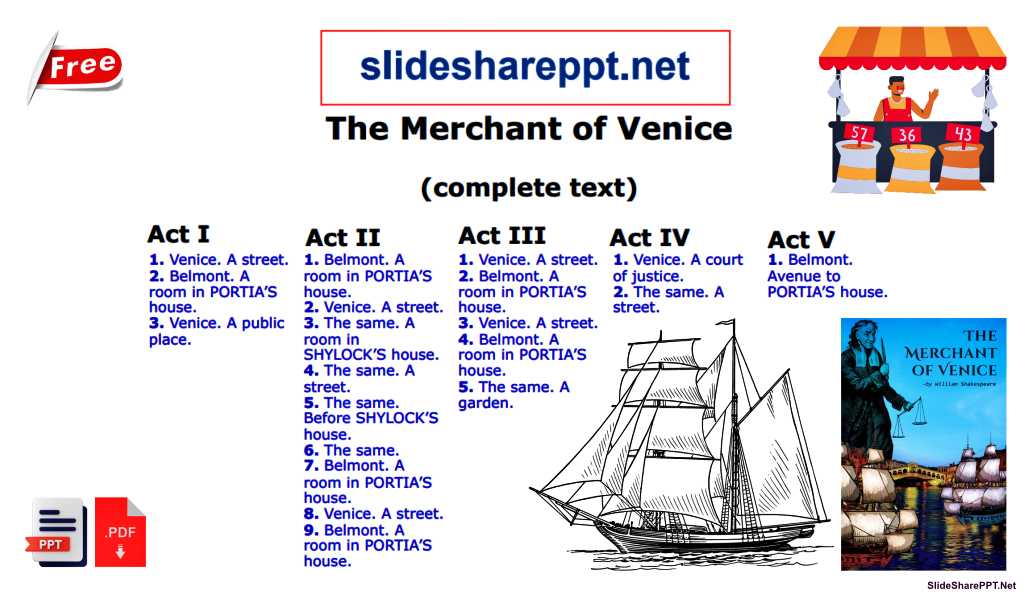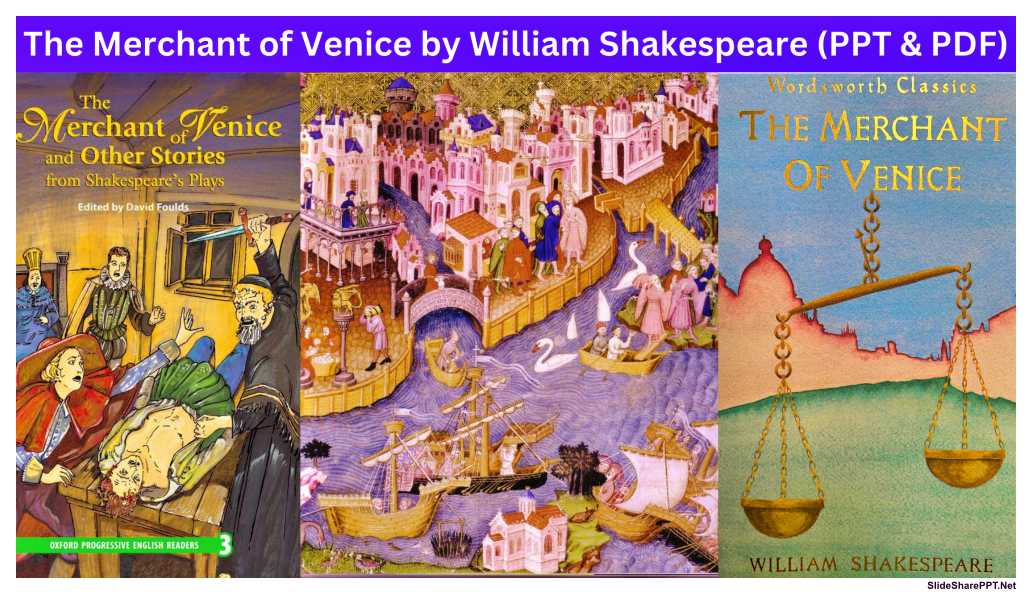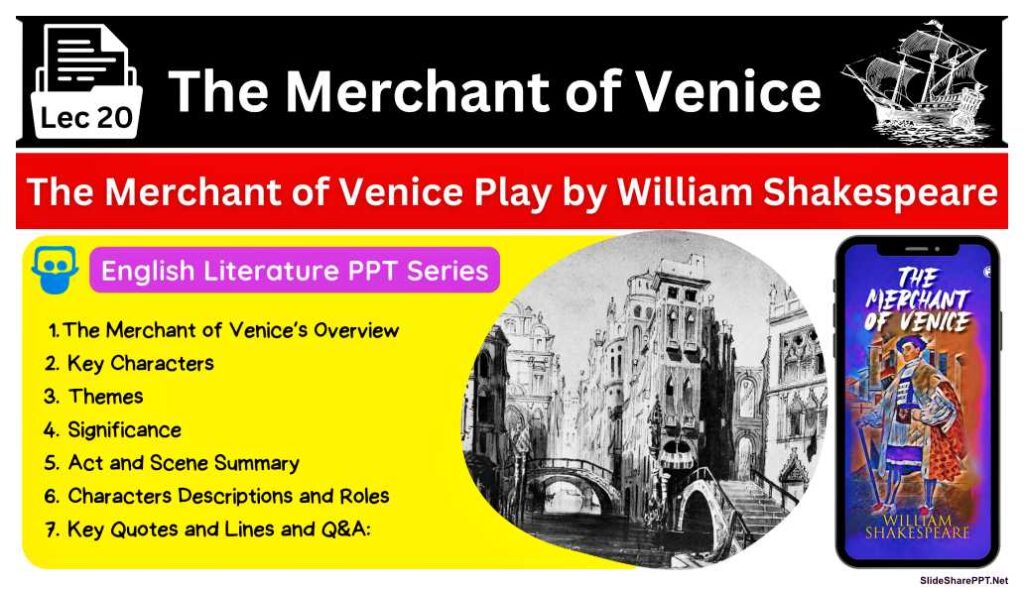The Merchant of Venice PPT Slides & PDF Download
Today we have shared the Notes of William Shakespeare’s Famous Play The Merchant of Venice PPT Slides & PDF Download, So as we know “The Merchant of Venice” by William Shakespeare stands as one of the most intriguing and controversial plays in English literature. Written around 1596, it delves into themes of love, greed, justice, and prejudice, presenting a complex narrative that continues to captivate audiences and provoke discussions centuries after its creation.
Table of The Merchant of Venice
Here’s a complete table for “The Merchant of Venice”:
| Aspect | Description |
|---|---|
| Title | The Merchant of Venice |
| Playwright | William Shakespeare |
| Genre | Comedy, tragicomedy |
| Date of Composition | Estimated to be between 1596 and 1599 |
| Setting | Venice and Belmont (Italy) |
| Main Characters | Antonio, Shylock, Portia, Bassanio, Jessica, Lorenzo, Gratiano, Nerissa |
| Plot Overview | The play revolves around the merchant Antonio, who borrows money from the Jewish moneylender Shylock to help his friend Bassanio woo the wealthy heiress Portia. When Antonio defaults on the loan, Shylock demands a pound of his flesh as repayment, leading to a dramatic trial. Meanwhile, Portia disguises herself as a male lawyer and intervenes to deliver a clever legal argument that ultimately saves Antonio. |
| Key Themes | Justice and mercy, prejudice and discrimination, friendship and loyalty, the nature of wealth and love |
| Significance | “The Merchant of Venice” is one of Shakespeare’s most controversial plays, known for its complex characters and exploration of themes related to money, religion, and justice. It has sparked debates over its portrayal of Jews and its treatment of themes such as mercy and revenge. |
| Notable Lines | – “All that glitters is not gold.” (Act 2, Scene 7) – “The quality of mercy is not strain’d, / It droppeth as the gentle rain from heaven / Upon the place beneath.” (Act 4, Scene 1) – “Hath not a Jew eyes? Hath not a Jew hands, organs, dimensions, senses, affections, passions?” (Act 3, Scene 1) |
| Adaptations | “The Merchant of Venice” has been adapted into various stage productions, films, and television adaptations. Notable adaptations include the film directed by Michael Radford (2004) starring Al Pacino as Shylock and numerous stage productions by renowned theater companies. |
This table provides a comprehensive overview of various aspects of “The Merchant of Venice,” including its background, plot, characters, themes, significance, notable lines, and adaptations.
The Merchant of Venice PPT Slides
(Lecture 20)
Important:-
- If you are viewing this PPT on your phone, please make it full screen and then view it. (Press: 3 dots in PPT, then Full Screen)
- If you have a problem while clicking on next, (Just tap) on the slide instead of clicking Next Botton.
- FOR A BETTER VIEW PRESS Ctrl + Shift + F ON A PC OR LAPTOP.
- Whatever is written in the PPT is different and whatever is written below is different.
About The Merchant of Venice
“The Merchant of Venice” is one of William Shakespeare’s most enduring and controversial plays. Set in Renaissance Venice, the play explores themes of love, friendship, justice, and prejudice, while showcasing Shakespeare’s masterful blend of comedy and drama. In this comprehensive guide, we will delve into the plot, characters, themes, and significance of “The Merchant of Venice,” offering readers a deeper understanding of this timeless classic.
“The Merchant of Venice” by William Shakespeare is a captivating play that unfolds in the vibrant city of Venice. At its core, the story revolves around the intertwined fates of several characters, each driven by their desires, ambitions, and the complexities of human nature.
- The play opens with Antonio, a wealthy merchant, expressing melancholy without knowing its cause. His friend Bassanio seeks financial assistance from Antonio to woo Portia, a wealthy heiress from Belmont. Antonio agrees to borrow money from the Jewish moneylender Shylock, using a pound of his own flesh as collateral.
- Meanwhile, in Belmont, Portia awaits suitors who must choose among three caskets to win her hand in marriage. The Prince of Morocco and the Prince of Arragon attempt the challenge but fail to choose the correct casket. Back in Venice, tensions rise as Shylock seeks to enforce the bond with Antonio after his ships are lost at sea, leaving him unable to repay the loan.
- The courtroom scene serves as the climax of the play, where Shylock demands his pound of flesh as repayment. Portia, disguised as a male lawyer, intervenes to save Antonio, delivering a powerful speech on the quality of mercy. Shylock’s punishment is severe, forcing him to convert to Christianity and forfeit his wealth.
- Amidst the courtroom drama, romantic subplots unfold as Jessica, Shylock’s daughter, elopes with Lorenzo, a Christian, and Portia’s maid Nerissa marries Gratiano, Bassanio’s friend. The play concludes with reconciliations and celebrations in Belmont, where love triumphs over prejudice and justice prevails over vengeance.
- “The Merchant of Venice” is a timeless masterpiece that explores themes of prejudice, justice, love, and mercy. Through its rich characters and intricate plot, Shakespeare challenges audiences to reflect on the complexities of human relationships and the moral dilemmas that define the human experience.
Significance: “The Merchant of Venice” remains relevant today for its exploration of timeless themes and its complex characters. The play’s examination of prejudice, justice, and the nature of humanity continues to resonate with audiences, sparking discussions about identity, discrimination, and morality. Additionally, “The Merchant of Venice” showcases Shakespeare’s ability to blend comedy and drama, offering moments of humor and levity alongside moments of intense emotion and moral complexity.
Conclusion: “The Merchant of Venice” stands as a rich and thought-provoking work of literature, offering readers and audiences alike a compelling exploration of human nature and society. Through its memorable characters, intricate plot, and enduring themes, the play continues to captivate and inspire, inviting us to reflect on the complexities of love, friendship, and justice in our own lives.

Note: The complete Text PDF Link is at the end of the PowerPoint slides (go to the last PPT Slide)
Characters
Here’s a comprehensive table outlining the key characters in William Shakespeare’s “The Merchant of Venice”:
| Character | Description and Role |
|---|---|
| Antonio | The titular merchant of Venice, known for his generosity and loyalty to his friends, particularly Bassanio. He agrees to borrow money from Shylock to help Bassanio woo Portia, ultimately leading to a dramatic courtroom trial over the repayment of the loan. |
| Shylock | A Jewish moneylender in Venice, often portrayed as a villain due to his vengeful pursuit of a pound of Antonio’s flesh as repayment for a defaulted loan. Shylock’s character raises questions about prejudice, justice, and the complexities of human nature. |
| Portia | A wealthy heiress from Belmont, clever and resourceful, who disguises herself as a male lawyer to save Antonio in court. Portia is also sought after by numerous suitors who must pass a test to win her hand in marriage, a plotline central to the play’s romantic elements. |
| Bassanio | A young Venetian nobleman and friend of Antonio, who seeks to win the hand of Portia through financial means. Bassanio’s quest for love and his reliance on Antonio for financial support drive much of the plot’s conflict and resolution. |
| Jessica | Shylock’s daughter, who elopes with Lorenzo, a Christian, causing further tension between her father and the Christian characters. Jessica’s character highlights themes of love, loyalty, and the conflicts between family ties and personal desires. |
| Lorenzo | A friend of Antonio and Bassanio, who elopes with Jessica, illustrating themes of love and interfaith relationships. Lorenzo’s character serves as a contrast to the prejudices and conflicts present in Venetian society, advocating for love and compassion across religious boundaries. |
| Nerissa | Portia’s witty and loyal servant, who assists her mistress in the courtroom disguise and in orchestrating the resolution of the play’s conflicts. Nerissa’s character adds humor and depth to the play while also demonstrating loyalty and intelligence in her service to Portia. |
| Gratiano | A friend of Bassanio and Antonio, known for his brash and impulsive nature. Gratiano’s character provides comedic relief and serves as a foil to the more serious and introspective characters in the play, contributing to the overall dynamic and atmosphere of the story. |
| The Prince of Morocco | One of Portia’s suitors, who attempts to win her hand by choosing the correct casket among gold, silver, and lead. The Prince of Morocco’s character reflects themes of appearance versus reality and challenges stereotypes associated with race and ethnicity. |
| The Prince of Arragon | Another of Portia’s suitors, who also attempts to win her hand by choosing the correct casket. The Prince of Arragon’s character highlights themes of arrogance and entitlement, contrasting with the qualities valued by Portia and the other characters in the play. |
This table offers insights into the key characters in “The Merchant of Venice,” their motivations, relationships, and roles within the play’s intricate plot.
Themes
Here’s a comprehensive table outlining the key themes of William Shakespeare’s “The Merchant of Venice”:
| Theme | Description |
|---|---|
| Prejudice and Discrimination | “The Merchant of Venice” confronts themes of religious and ethnic prejudice, particularly in its portrayal of Shylock as a Jewish antagonist and the discrimination he faces at the hands of the Christian characters. The play explores the harmful effects of prejudice and the importance of tolerance and understanding. |
| Justice and Mercy | The play delves into the concepts of justice and mercy, particularly in the courtroom scene where Portia delivers her famous speech on the quality of mercy. “The Merchant of Venice” raises questions about the nature of justice, the power of forgiveness, and the complexities of human morality. |
| Love and Friendship | Love and friendship are central themes in “The Merchant of Venice,” as characters navigate romantic relationships and demonstrate loyalty and devotion to one another. The play explores different forms of love, including romantic love, familial love, and friendship, highlighting the power of human connections. |
| Appearance vs. Reality | “The Merchant of Venice” explores the dichotomy between appearance and reality, as characters conceal their true identities and motivations, leading to unexpected revelations and plot twists. The play raises questions about the nature of truth, perception, and the masks people wear in society. |
| Wealth and Materialism | The pursuit of wealth and material possessions drives much of the plot’s conflict in “The Merchant of Venice,” particularly in Bassanio’s quest to win Portia’s hand through financial means. The play examines the consequences of materialism and the value of wealth in society, raising questions about greed, generosity, and happiness. |
This table provides a comprehensive overview of the central themes explored in “The Merchant of Venice,” offering insights into the play’s exploration of prejudice, justice, love, appearance, and materialism.
Significance
Here’s a comprehensive table highlighting the significance of William Shakespeare’s “The Merchant of Venice”:
| Aspect | Significance |
|---|---|
| Exploration of Prejudice and Discrimination | “The Merchant of Venice” is significant for its exploration of prejudice and discrimination, particularly in its portrayal of Shylock as a Jewish antagonist and the discrimination he faces at the hands of the Christian characters. The play raises questions about the harmful effects of prejudice and the importance of tolerance and understanding. |
| Examination of Justice and Mercy | The play delves into the concepts of justice and mercy, particularly in the courtroom scene where Portia delivers her famous speech on the quality of mercy. “The Merchant of Venice” raises questions about the nature of justice, the power of forgiveness, and the complexities of human morality. |
| Representation of Love and Friendship | Love and friendship are central themes in “The Merchant of Venice,” as characters navigate romantic relationships and demonstrate loyalty and devotion to one another. The play explores different forms of love, highlighting the power of human connections and the bonds that unite people. |
| Exploration of Appearance vs. Reality | “The Merchant of Venice” explores the dichotomy between appearance and reality, as characters conceal their true identities and motivations, leading to unexpected revelations and plot twists. The play raises questions about the nature of truth, perception, and the masks people wear in society. |
| Commentary on Wealth and Materialism | The pursuit of wealth and material possessions drives much of the plot’s conflict in “The Merchant of Venice,” raising questions about greed, generosity, and the value of wealth in society. The play examines the consequences of materialism and explores the relationship between wealth and happiness. |
| Cultural and Historical Impact | “The Merchant of Venice” has had a significant cultural and historical impact, influencing discussions about prejudice, justice, and morality. The play’s exploration of themes such as discrimination and forgiveness continues to resonate with audiences today, sparking debates about identity, tolerance, and compassion. |
This table provides insights into the significance of “The Merchant of Venice” within both its historical context and its broader cultural and literary impact.
Act and Scene Summary
Here’s a table summarizing each act and scene of William Shakespeare’s “The Merchant of Venice”:
| Act | Scene | Summary |
|---|---|---|
| Act 1 | Scene 1 | The play opens in Venice, where Antonio, a wealthy merchant, expresses sadness without knowing the cause. His friend Bassanio seeks a loan from him to woo Portia, a wealthy heiress from Belmont. Antonio agrees to borrow money on Bassanio’s behalf from the Jewish moneylender, Shylock, using a pound of his own flesh as collateral. |
| Act 1 | Scene 2 | Portia discusses her suitors with Nerissa, her maid, expressing her disdain for the Prince of Morocco and the Prince of Arragon. She reveals her hope that Bassanio, whom she has feelings for, will choose the correct casket and win her hand in marriage. |
| Act 2 | Scene 1 | The Prince of Morocco arrives to try his luck at winning Portia’s hand by choosing among three caskets—gold, silver, and lead. |
| Act 2 | Scene 2 | The Prince of Arragon also arrives to choose a casket and win Portia’s hand. |
| Act 2 | Scene 3 | In Venice, Shylock is angered by Jessica’s elopement with Lorenzo, a Christian. |
| Act 2 | Scene 4 | In Belmont, the correct suitor for Portia’s hand must choose among the caskets. |
| Act 2 | Scene 5 | Lorenzo and Jessica elope, and Gratiano and Salarino join them. |
| Act 2 | Scene 6 | The tension between Shylock and Antonio escalates, and Bassanio departs for Belmont. |
| Act 3 | Scene 1 | In Belmont, the Prince of Morocco chooses the gold casket and fails to win Portia’s hand. |
| Act 3 | Scene 2 | In Venice, Shylock plans to enforce the bond with Antonio. |
| Act 3 | Scene 3 | Jessica is ashamed of her father and his actions. |
| Act 3 | Scene 4 | In Belmont, the Prince of Arragon chooses the silver casket and fails to win Portia’s hand. |
| Act 3 | Scene 5 | Lorenzo, Jessica, and Salerio await Bassanio’s arrival in Belmont. |
| Act 4 | Scene 1 | The courtroom scene begins, with Shylock seeking to enforce the bond with Antonio. |
| Act 5 | Scene 1 | The resolution occurs with the trial, the disguised Portia intervenes to save Antonio, and the characters reunite in Belmont. |
This table provides a structured summary of the main events and developments in each act and scene of “The Merchant of Venice,” capturing the essence of the play’s intricate plot and dramatic tension.
Characters Descriptions and Roles
Here’s a table providing descriptions and roles of key characters in William Shakespeare’s “The Merchant of Venice”:
| Character | Description and Role |
|---|---|
| Antonio | The titular merchant of Venice, known for his generosity and loyalty to his friends, particularly Bassanio. He agrees to borrow money from Shylock to help Bassanio woo Portia, ultimately leading to a dramatic courtroom trial over the repayment of the loan. |
| Shylock | A Jewish moneylender in Venice, often portrayed as a villain due to his vengeful pursuit of a pound of Antonio’s flesh as repayment for a defaulted loan. Shylock’s character raises questions about prejudice, justice, and the complexities of human nature. |
| Portia | A wealthy heiress from Belmont, clever and resourceful, who disguises herself as a male lawyer to save Antonio in court. Portia is also sought after by numerous suitors who must pass a test to win her hand in marriage, a plotline central to the play’s romantic elements. |
| Bassanio | A young Venetian nobleman and friend of Antonio, who seeks to win the hand of Portia through financial means. Bassanio’s quest for love and his reliance on Antonio for financial support drive much of the plot’s conflict and resolution. |
| Jessica | Shylock’s daughter, who elopes with Lorenzo, a Christian, causing further tension between her father and the Christian characters. Jessica’s character highlights themes of love, loyalty, and the conflicts between family ties and personal desires. |
| Lorenzo | A friend of Antonio and Bassanio, who elopes with Jessica, illustrates themes of love and interfaith relationships. Lorenzo’s character serves as a contrast to the prejudices and conflicts present in Venetian society, advocating for love and compassion across religious boundaries. |
| Nerissa | Portia’s witty and loyal servant, who assists her mistress in the courtroom disguise and in orchestrating the resolution of the play’s conflicts. Nerissa’s character adds humor and depth to the play while also demonstrating loyalty and intelligence in her service to Portia. |
| Gratiano | A friend of Bassanio and Antonio, known for his brash and impulsive nature. Gratiano’s character provides comedic relief and serves as a foil to the more serious and introspective characters in the play, contributing to the overall dynamic and atmosphere of the story. |
| The Prince of Morocco | One of Portia’s suitors, who attempts to win her hand by choosing the correct casket among gold, silver, and lead. The Prince of Morocco’s character reflects themes of appearance versus reality and challenges stereotypes associated with race and ethnicity. |
| The Prince of Arragon | Another of Portia’s suitors, who also attempts to win her hand by choosing the correct casket. The Prince of Arragon’s character highlights themes of arrogance and entitlement, contrasting with the qualities valued by Portia and the other characters in the play. |
These descriptions offer insights into the key characters in “The Merchant of Venice,” their motivations, relationships, and roles within the play’s intricate plot.
Key Quotes and Lines
Here’s a table featuring key quotes and lines from William Shakespeare’s “The Merchant of Venice”:
| Character | Quote |
|---|---|
| Portia | “The quality of mercy is not strained, It droppeth as the gentle rain from heaven Upon the place beneath. It is twice blest: It blesseth him that gives and him that takes.” |
| Shylock | “Hath not a Jew eyes? Hath not a Jew hands, organs, dimensions, senses, affections, passions? Fed with the same food, hurt with the same weapons, subject to the same diseases, healed by the same means, warmed and cooled by the same winter and summer, as a Christian is? If you prick us, do we not bleed? If you tickle us, do we not laugh? If you poison us, do we not die? And if you wrong us, shall we not revenge?” |
| Bassanio | “So may the outward shows be least themselves; The world is still deceived with ornament.” |
| Antonio | “I hold the world but as the world, Gratiano; A stage where every man must play a part, And mine a sad one.” |
| Portia | “In Belmont is a lady richly left, And she is fair and, fairer than that word, Of wondrous virtues.” |
| Shylock | “I am a Jew. Hath not a Jew eyes? Hath not a Jew hands, organs, dimensions, senses, affections, passions?” |
| Gratiano | “Let me play the fool: With mirth and laughter let old wrinkles come, And let my liver rather heat with wine Than my heart cool with mortifying groans.” |
| Portia | “How far that little candle throws his beams! So shines a good deed in a naughty world.” |
| Shylock | “If you prick us, do we not bleed? If you tickle us, do we not laugh? If you poison us, do we not die? And if you wrong us, shall we not revenge?” |
| Bassanio | “But love is blind, and lovers cannot see The pretty follies that themselves commit.” |
These quotes capture the essence of “The Merchant of Venice,” showcasing the eloquence and depth of Shakespeare’s language while highlighting the key themes and characters within the play.

Q&A:
Q: What is the central conflict in “The Merchant of Venice”?
A: The central conflict revolves around Antonio’s borrowing of money from Shylock to help Bassanio court Portia. When Antonio’s ventures fail, he cannot repay the loan, leading to Shylock’s demand for a pound of Antonio’s flesh as repayment.
Q: Who are the main characters in “The Merchant of Venice”?
A: The main characters include Antonio, the merchant; Bassanio, his friend; Portia, a wealthy heiress; Shylock, a Jewish moneylender; and Jessica, Shylock’s daughter.
Q: What role does the character of Portia play in the play’s resolution?
A: Portia plays a pivotal role in the resolution by disguising herself as a male lawyer to argue Antonio’s case in court. Through legal cunning and appeals to mercy, she saves Antonio from Shylock’s harsh punishment.
Q: How does the play explore themes of prejudice and discrimination?
A: The play portrays the anti-Semitic attitudes of Venice through Shylock’s mistreatment and discrimination based on his Jewish heritage. It delves into societal biases and challenges perceptions of justice and mercy.
Q: What are the caskets in the play, and what do they represent?
A: The caskets are chests that suitors must choose from to win Portia’s hand in marriage. They represent the inner qualities of the suitors; the correct choice signifies a deep understanding of love and loyalty beyond superficial appearances.
Q: Discuss the significance of the bond between Antonio and Bassanio.
A: The bond between Antonio and Bassanio showcases deep friendship and loyalty. Antonio’s willingness to risk his life for Bassanio reflects themes of sacrifice and devotion central to the play.
Q: How does Shylock’s character challenge Elizabethan stereotypes?
A: Shylock challenges stereotypes by presenting a complex Jewish character with human emotions and motivations. His portrayal questions societal prejudices and invites empathy for marginalized individuals.
Q: What is the outcome of the trial scene involving Shylock and Antonio?
A: In the trial scene, Portia intervenes disguised as a lawyer and uses legal technicalities to thwart Shylock’s harsh claim for a pound of Antonio’s flesh. The court rules in favor of Antonio, highlighting themes of justice tempered with mercy.
Q: How does the play address the theme of mercy vs. justice?
A: The play juxtaposes strict interpretations of justice, as seen in Shylock’s desire for retribution, with Portia’s plea for mercy. It invites audiences to ponder the balance between legal rulings and humane considerations.
Q: Why is “The Merchant of Venice” considered a problematic play by some critics?
A: Critics often debate the play’s portrayal of Shylock, citing concerns about anti-Semitic stereotypes perpetuated through his character. The play’s treatment of themes like prejudice and justice requires nuanced interpretation and sensitivity to historical contexts.
Q: How is the theme of prejudice explored in the play?
A: The theme of prejudice is explored through the character of Shylock, who faces discrimination and hatred because of his Jewish identity. Shylock’s mistreatment by the Christian characters, particularly Antonio, highlights the anti-Semitic attitudes prevalent in Venetian society. The play also delves into the consequences of prejudice and the importance of empathy and understanding.
Q: What role does Portia play in the resolution of the conflict?
A: Portia plays a crucial role in the resolution of the conflict by disguising herself as a male lawyer and intervening in the courtroom scene to save Antonio. Through her intelligence and wit, Portia presents a legal argument that ultimately spares Antonio’s life while exposing the flaws in Shylock’s pursuit of vengeance. Portia’s actions showcase the power of mercy and justice in overcoming prejudice and hatred.
Q: How does “The Merchant of Venice” reflect the social and cultural context of its time?
A: “The Merchant of Venice” reflects the social and cultural context of Renaissance-era Venice, where tensions between Christians and Jews were prevalent. The play explores themes of religious intolerance, prejudice, and justice, reflecting the complexities of Venetian society. Additionally, the portrayal of gender roles and expectations, particularly through characters like Portia, offers insights into Renaissance attitudes towards women and marriage.
Q: What are some of the moral dilemmas presented in the play?
A: “The Merchant of Venice” presents several moral dilemmas, including the conflict between mercy and justice, the consequences of prejudice and discrimination, and the complexities of loyalty and friendship. Characters grapple with questions of right and wrong, often facing difficult choices that reveal the complexities of human nature and the moral ambiguity of the world they inhabit.
MCQ:
Q: What is the primary occupation of the protagonist, Antonio, in “The Merchant of Venice”?
A) Lawyer
B) Merchant
C) Soldier
D) Artist
Answer: B) Merchant
Q: Who borrows money from Shylock on Antonio’s behalf?
A) Portia
B) Bassanio
C) Gratiano
D) Lorenzo
Answer: B) Bassanio
Q: What is the condition Shylock sets for lending money to Antonio?
A) Antonio must give up his title as a merchant.
B) Antonio must marry Shylock’s daughter.
C) Antonio must give Shylock a pound of his flesh if the loan is not repaid.
D) Antonio must convert to Judaism.
Answer: C) Antonio must give Shylock a pound of his flesh if the loan is not repaid.
Q: Who disguises herself as a male lawyer to save Antonio in court?
A) Nerissa
B) Jessica
C) Portia
D) Beatrice
Answer: C) Portia
Q: What choice does each suitor in the play have to make to win Portia’s hand in marriage?
A) Solve a riddle about love and loyalty.
B) Perform a series of challenging tasks.
C) Present a valuable gift to Portia.
D) Duel with each other to prove their bravery.
Answer: A) Solve a riddle about love and loyalty.
Q: What is the outcome of the trial scene involving Shylock and Antonio?
A) Shylock wins and claims his pound of flesh.
B) Antonio pays off the debt and avoids harm.
C) Portia convinces Shylock to forgive the debt.
D) The court rules in favor of Bassanio and dismisses Shylock’s claim.
Answer: D) The court rules in favor of Bassanio and dismisses Shylock’s claim.
Q: Which character inherits a considerable sum of money and property at the end of the play?
A) Bassanio
B) Shylock
C) Antonio
D) Jessica
Answer: D) Jessica
Q: What themes are prominently explored in “The Merchant of Venice”?
A) Love and Betrayal
B) Justice and Revenge
C) Loyalty and Deception
D) All of the above
Answer: D) All of the above
Q: Which historical context adds complexity to discussions about “The Merchant of Venice”?
A) The Elizabethan Era’s views on money lending
B) The Renaissance’s impact on art and literature
C) Shakespeare’s portrayal of Jewish characters amidst prevalent anti-Semitic attitudes
D) The influence of Italian culture on English playwrights
Answer: C) Shakespeare’s portrayal of Jewish characters amidst prevalent anti-Semitic attitudes
Q: Why does “The Merchant of Venice” continue to be a topic of discussion and analysis in modern times?
A) Its exploration of timeless themes like prejudice, justice, and love
B) Its controversial portrayal of Shylock and anti-Semitism
C) Its enduring relevance to societal issues and human behavior
D) All of the above
Answer: D) All of the above
Also read: Titus Andronicus PPT Slides & PDF Download



